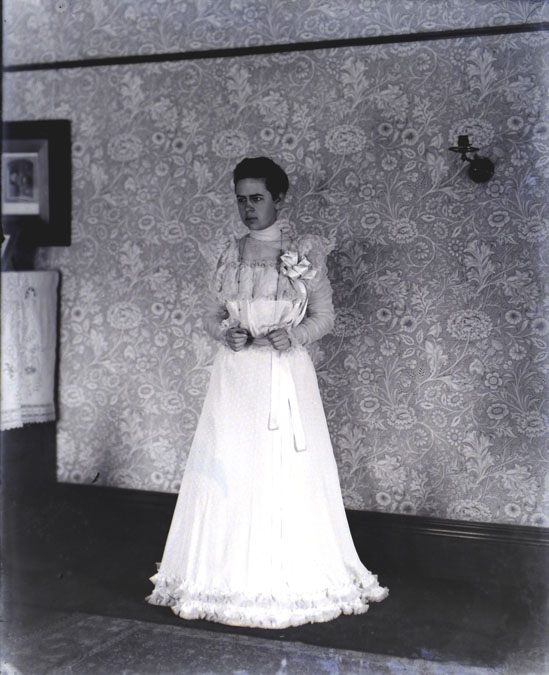Glessner Family
John Jacob Glessner
John Jacob Glessner was born January 26, 1843, in Zanesville, Ohio. While his father served for two years in the Ohio legislature, John ran the elder Glessner's Zanesville Times. In 1863, John moved to Springfield, Ohio, to begin a career in the farm implement industry, beginning with a post with Warder, Child & Co, which in 1866 reorganized into Warder, Mitchell & Co. John became a junior partner. John had met Frances Macbeth, when he moved into her mother’s boarding house in 1863; they married on December 7, 1870.
The couple soon moved to Chicago, where John took over management of the sales office for the firm. In 1879 he was made a full partner and the company was reorganized as Warder, Bushnell and Glessner. In 1882, John commissioned Isaac Scott to design a new headquarters for Warder, Bushnell & Glessner on Jefferson St, and in 1886 John became sole Vice President of the firm. In 1902, John was a key figure in the merger of his company with McCormick, Deering, Plano Manufacturing, and Milwaukee Harvester Company. The resulting company, International Harvester, ended the “reaper wars.” John was named a vice president and served as chairman of the executive committee.
Throughout his life in Chicago, John Glessner played an active role in civic affairs. At times, he served on the boards of the Citizens Association of Chicago, Chicago Relief and Aid Society, Chicago Orphan Asylum, Rush Medical College, and the Art Institute of Chicago. He also participated in the Chicago, Union League, Quadrangle and Chicago Literary Clubs as an active member. Perhaps most significantly, he served as a trustee of the Chicago Orchestral Association.
John was also a prolific writer, producing many short pieces relating family history—including a tribute to his wife after her death—as well as more obscure topics like potatoes and snakes.
John Glessner died on January 20, 1936, a week before his ninety-third birthday and was interred at Graceland Cemetery beside his wife. Family and friends remembered him as a quiet and modest man whose industry and intelligence seem to have had a profound, though at times barely visible, effect on everything around him. Although his name is not as well known as some of his contemporaries, such as Marshall Field or George Pullman, his influence on the development of Gilded Age Chicago was considerable and his impact is still felt in many cultural institutions in Chicago today.
Frances Macbeth Glessner
Sarah Frances Macbeth was born January 1, 1848, in Urbana, Ohio. The following year, the family moved to Springfield, Ohio. When she was three years old, Frances’s father headed west in search of gold. He remained in California until 1854, before taking a series of jobs in New York, where he worked for fifteen years, visiting the family in Ohio twice a year.
In 1863, the Macbeth family took in a boarder, John Glessner. John and Frances married in 1870 and moved almost immediately to Chicago.
In 1879, Frances began keeping the journal she would write for the next forty years, providing insight into daily life at the Glessners’ house. Her husband would frequently complete diary entries whenever she was ill. Frances was a talented seamstress and needleworker, and visitors to the house may see many of her pieces still on display. She was also a silversmith, accomplished pianist, and avid knitter; she gave away many of her silver pieces as gifts and purportedly knitted more than 500 sweaters for children, employees, and servicemen. She studied with Annibale Fogliata, a master jewelry craftsman of Hull House, and Madeline Yale Wynne, a noted Chicago silversmith. In 1904 Frances set up a workbench in the basement of Glessner House and began producing simple and elegant objects. Her pieces bear her hallmark, a “G” encircling a honeybee, iconography for another interest: bee keeping.
Frances Glessner was also a patron of the fine arts. She co-founded the Chicago Chamber Music Society and in her lifetime was also an active member of the several other social and philanthropic organizations, including The Fortnightly, Antiquarian Society of the Art Institute of Chicago, and its predecessor, the Chicago Society of Decorative Art. Proud of her family heritage, she was a founding member of the Chicago Chapter of the D.A.R., the first local chapter established in the country, and also later joined the Colonial Dames. She also attended all rehearsals and performances given by the Chicago Symphony Orchestra, one of her greatest passions.
In 1893, William Rainey Harper, then president of the University of Chicago, asked Frances for advice on how to introduce faculty wives to women of the city. The result was Frances’s Monday Morning Reading Class, which met for two hours in the library of the house every Monday from October to May. During the first hour, the women sewed and listened to a professional reader; during the second hour, there was lighter reading or a lecture. Membership in the class was by invitation only, and the class continued until 1930, when Frances Glessner’s failing health made it impossible to continue.
France Glessner died at the age of 84 on October 19, 1932. In his book, The Story of a House, John Glessner described his wife with much admiration. “She had a clean and wholesome and orderly mind, a heart overflowing with love for family and friends and for all in any need. Her remarkable sense of the value of color and fabric and form and arrangement were what made our three homes in Chicago so attractive.”
John George Macbeth Glessner
George Macbeth Glessner, the oldest child and only surviving son of John and Frances Glessner, was born October 2, 1871, just a week before the Great Chicago Fire raged a block from John Glessner’s office but left the family’s house on Park Avenue untouched. Three years later, Frances gave birth to their second son, John Francis. When the baby died at eight months old, George asked that the name John be attached to the front of his own name.
An early case of hay fever left George in delicate health. The family’s doctor advised the Glessners to spend the summer hay fever season away from Chicago, someplace where George would be free from the malady. In 1883, John Glessner completed the “Big House” at his new summer estate, The Rocks, on land he had purchased the previous year. The Rocks became a wonderland for George and the Glessners’ summer home; the family spent nearly five months of the year there.
George’s hay fever also resulted in a series of tutors at home. He was, by all accounts, a precocious learner. In 1884, George printed a collection of poems and photographs in a volume entitled The Little Joker. He also loved tinkering with anything mechanical. George installed a telegraph in the houses of six nearby friends so that they could communicate with each, as well as a fire signal repeater so that he would be notified of the excitement of any area fire.
Photography was George’s lifelong passion. He owned at least three different cameras and developed many of his photos in his chemical laboratory in the basement of Glessner House. Within the first year that the family lived on Prairie Avenue (1887-88), George extensively documented the house and its contents. He kept meticulous records with detailed labels on each photograph and negative, and his photographs were used during the restoration of the house.
After graduating from Harvard in 1893, George joined his father at Warder, Bushnell and Glessner, first as a purchasing agent and, later, as an assistant manager. He married Alice Hamlin in June 1898. The couple had four children: Elizabeth (1899), Frances (1900), John (1902), and Emily (1904). In 1902, with the organization of International Harvester, George was named utility manager of the company. He would come to play a major role in the management of The Rocks, the Glessners’ New Hampshire estate, which employed over seventy people. In 1915, George and his family settled permanently on The Rocks property in a new home they built named The Ledge. In New Hampshire, George got involved in politics, representing the town of Bethlehem in the state legislature for four terms, between 1913 and 1927. He played a lead role in establishing New Hampshire as the site of the first presidential primary in the country. He also served as manager of the Bethlehem Electric Company and the Lisbon Light and Power Company.
In December 1928, George contracted influenza while he and Alice were visiting their daughter Frances in Paris. His health improved but appendicitis and pneumonia soon followed. He died in January 1929.
Frances Glessner Lee (Fanny as a child)
Fanny Glessner was born in Chicago on March 25, 1878, the youngest child and only daughter of John and Frances Glessner. In her journal, Frances described her daughter as a delightful, clever and precocious little girl. Fanny was tutored at home like her brother George.
Fanny's early adult life unfolded in much the same way as the lives of other wealthy girls at the time. After receiving an excellent education at home, she then spent fourteen months in 1896 and 1897 touring Europe with her mother's sister, Helen Macbeth. Five months after her return, in November 1897, she made her formal Chicago society debut. On February 9, 1898, she married Blewett Lee, a law partner of one of George's friends. Within a few years, the couple moved one block to the north into 1700 S. Prairie Avenue (demolished), one of two twin townhouses that John and Frances built for their children. Frances and Blewett had three children, John Glessner Lee (1898), Frances Lee (1903) and Martha Lee (1906). The marriage was not a happy one and the couple divorced in 1914.
In 1938, Frances took up permanent residence at The Cottage, her own home at her parents' summer estate, The Rocks, in New Hampshire. Previously, she had managed a house in Boston for soldiers and sailors returning from World War I, and then sold antiques in New Hampshire before pursuing her growing interest in legal medicine. Her friendship with Dr. George Burgess Magrath, medical examiner for Suffolk County in Massachusetts, had already piqued her enthusiasm and her philanthropic spirit—in 1931 she gave $250,000 to Harvard University to create a chair in legal medicine, and in 1934 she gave a collection of 1,000 volumes to create the Magrath Library of Legal Medicine. In 1943, New Hampshire appointed her State Police Captain, making her the first female state police captain in the country.
She created a series of twenty miniature crime scenes, the Nutshell Studies of Unexplained Death, drawing on the miniature model-making at which she had become quite adept. The models became an essential teaching tool in what became prestigious, biannual seminars, known as the Seminars in Homicide Investigation for State Police. Erle Stanley Gardner, the author of the Perry Mason novels and one of the few laymen allowed to attend the seminars, dedicated The Case of the Dubious Bridegroom to her. Gardner wrote that Frances Lee had a logical, orderly mind that was suited for police work. He described her as a perfectionist, with a warm heart and a keen sense of justice.
Frances Glessner Lee died at The Rocks on January 27, 1962. She was 83. Gardner's tribute to her was published on the front page of The Boston Globe. Harvard closed the department of legal medicine in 1967. Since that time the seminars have been held in Baltimore at the Office of the Chief Medical Examiner for the State of Maryland, and the Nutshell Studies continue to be used as part of the training.
On October 20, 2017, the nineteen surviving Nutshell Studies were placed on public exhibition for the first time ever at the Renwick Gallery of the Smithsonian American Art Museum in Washington, D.C. in an exhibit entitled "Murder Is Her Hobby: Frances Glessner Lee and the Nutshell Studies of Unexplained Death." The exhibit closed January 28, 2018.





